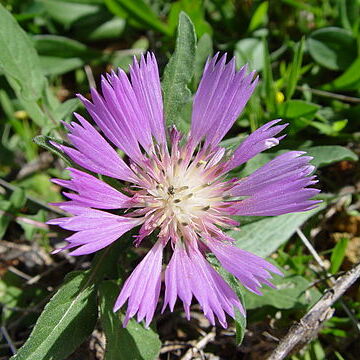Heads discoid, the fls sometimes all tubular and perfect, or more often the marginal ones neutral, with enlarged, irregular, falsely radiate cor; invol bracts imbricate in several series, dry, sometimes spine-tipped, more often some of them with enlarged, scarious or hyaline, erose or lacerate or pectinate terminal appendage, seldom all merely rounded above and entire; receptacle nearly flat, densely bristly; cors anthocyanic to yellow or white, with slender tube, short throat, and long narrow lobes; anthers with a narrow, firm, apical appendage, evidently (though often shortly) tailed at base; styles with a thickened, often hairy ring and an abrupt change of texture at the base of the papillate branches; achenes obliquely or laterally attached to the receptacle, seldom evidently nerved; pappus of several series of graduated bristles or narrow scales, often much reduced, or wanting; herbs with alternate or all basal, entire to pinnatifid lvs. 500+, mostly Old World.
Annual or biennial herbs. Stems erect, strongly branched, longitudinally striate; wings present or absent. Leaves entire to pinnatisect. Capitula sessile or pedunculate, ovoid, heterogamous, rarely homogamous. Involucral bracts adpressed, imbricate, entire to pectinate, often spine-tipped at apex. Receptacle flat, not alveolate, densely setose. Outer florets neuter, spreading. Inner florets fertile, bisexual; tube slender; lobes linear. Anthers sagittate-caudate; filaments free, smooth to papillose. Style branches connate or separated, erect. Achenes cylindrical to ellipsoid, slightly compressed, glabrous or hairy; carpopodium lateral. Pappus sometimes absent, otherwise persistent, of numerous free, barbellate, ensiform bristles (rarely awns).
Florets tubular, the outer series neuter sometimes with staminodes, the inner florets hermaphrodite; corollas whitish, purple, pink, blue or yellow, slender tubular below, dilated and deeply 5(8)-lobed above; anther bases sagittate, adjacent lobes connate into a short or long tail; style 2-branched, abruptly swollen below the branches with a ring of hairs at or below the swelling; the branches erect, long somewhat flat and ± connate, diverging only near the tips.
Herbs or subshrubs. Leaves alternate, usually dissected. Capitula solitary or corymbose, heterogamous and disciform or radiant, or homogamous; phyllaries multiseriate, with fimbriate appendages; receptacle densely setose. Florets with linear, sagittate anthers, with distal lanceolate appendage; style shortly bifid, abruptly swollen below the branches and with a ring of hairs at or below the swelling. Achenes somewhat compressed; pappus generally double.
Involucre ovoid-subglobose, hemispheric or nearly cylindric, araneose or glabrous; phyllaries many-seriate, imbricate, coriaceous, with a ± patent pectinate or spinose appendage.
Achenes oblong or obovoid, ± laterally compressed, apex rounded to truncate, glabrous when ripe, attachment-scar lateral-oblique, ± concave.
Perennial or annual herbs (shrubs), hirsute-scabridulous or tomentose-araneose, often with sessile glands, rarely glabrous.
Leaves alternate (or radical), entire, dentate or sometimes pinnatilobed (spiny), bases sometimes decurrent on the stem.
Pappus many-seriate of unequal barbellate (or plumose) scale-like setae, persistent (caducous or absent).
Capitula solitary (or paniculate), heterogamous, radiant.
Receptacle densely setose, the setae smooth and twisted.

